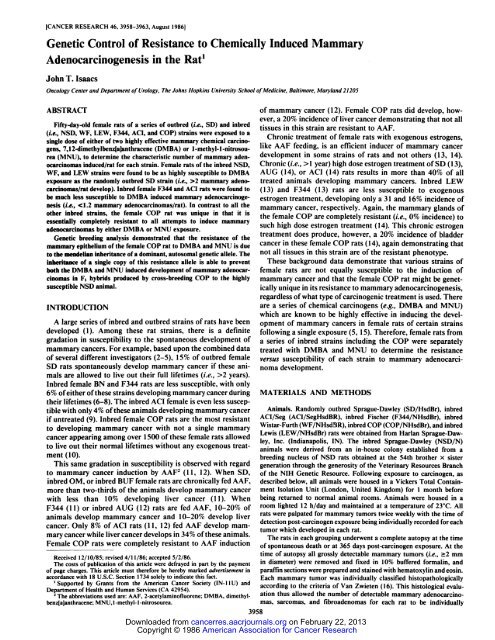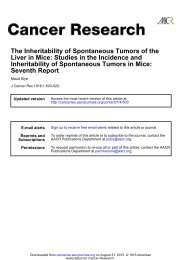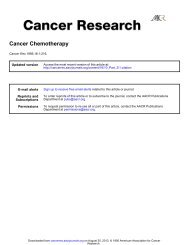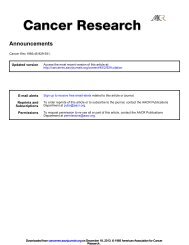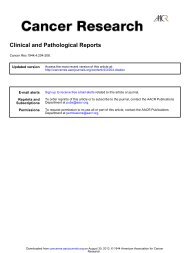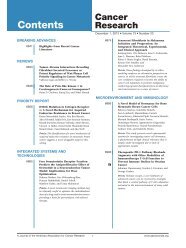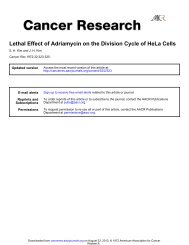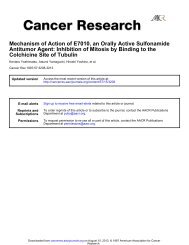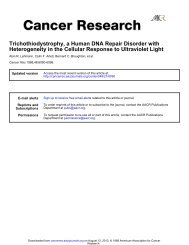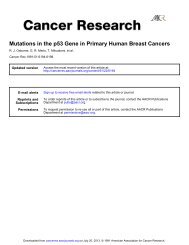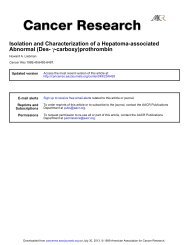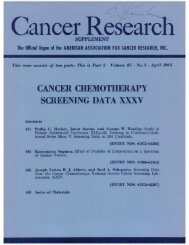Genetic Control of Resistance to Chemically ... - Cancer Research
Genetic Control of Resistance to Chemically ... - Cancer Research
Genetic Control of Resistance to Chemically ... - Cancer Research
Create successful ePaper yourself
Turn your PDF publications into a flip-book with our unique Google optimized e-Paper software.
(CANCER RESEARCH 46, 3958-3963, August 1986]<br />
<strong>Genetic</strong> <strong>Control</strong> <strong>of</strong> <strong>Resistance</strong> <strong>to</strong> <strong>Chemically</strong> Induced Mammary<br />
Adenocarcinogenesis in the Rat1<br />
John T. Isaacs<br />
Oncology Center and Department <strong>of</strong> Urology, The Johns Hopkins University School <strong>of</strong> Medicine, Baltimore, Maryland 21205<br />
ABSTRACT<br />
Fifty-day-old female rats <strong>of</strong> a series <strong>of</strong> outbred (i.e., SD) and inbred<br />
(i.e., NSD, WF, LEW, F344, ACI, and COP) strains were exposed <strong>to</strong> a<br />
single dose <strong>of</strong> either <strong>of</strong> two highly effective mammary chemical carcino<br />
gens, 7,12-dimethylbenzfa|anthracene (DMBA) or 1-methyl-1-nitrosourea<br />
(MM), <strong>to</strong> determine the characteristic number <strong>of</strong> mammary adenocarcinomas<br />
induced/rat for each strain. Female rats <strong>of</strong> the inbred NSD,<br />
WF, and LEW strains were found <strong>to</strong> be as highly susceptible <strong>to</strong> DMBA<br />
exposure as the randomly outbred SD strain (i.e., >2 mammary adenocarcinomas/rat<br />
develop). Inbred female F344 and ACI rats were found <strong>to</strong><br />
be much less susceptible <strong>to</strong> DMBA induced mammary adenocarcinogenesis<br />
(i.e., 2 years).<br />
Inbred female BN and F344 rats are less susceptible, with only<br />
6% <strong>of</strong> either <strong>of</strong> these strains developing mammary cancer during<br />
their lifetimes (6-8). The inbred ACI female is even less suscep<br />
tible with only 4% <strong>of</strong> these animals developing mammary cancer<br />
if untreated (9). Inbred female COP rats are the most resistant<br />
<strong>to</strong> developing mammary cancer with not a single mammary<br />
cancer appearing among over 1500 <strong>of</strong> these female rats allowed<br />
<strong>to</strong> live out their normal lifetimes without any exogenous treat<br />
ment (10).<br />
This same gradation in susceptibility is observed with regard<br />
<strong>to</strong> mammary cancer induction by AAF2 (11, 12). When SD,<br />
inbred OM, or inbred BUF female rats are chronically fed AAF,<br />
more than two-thirds <strong>of</strong> the animals develop mammary cancer<br />
with less than 10% developing liver cancer (11). When<br />
F344 (11) or inbred AUG (12) rats are fed AAF, 10-20% <strong>of</strong><br />
animals develop mammary cancer and 10-20% develop liver<br />
cancer. Only 8% <strong>of</strong> ACI rats (11, 12) fed AAF develop mam<br />
mary cancer while liver cancer develops in 34% <strong>of</strong> these animals.<br />
Female COP rats were completely resistant <strong>to</strong> AAF induction<br />
Received 12/10/85; revised 4/11/86; accepted 5/2/86.<br />
The costs <strong>of</strong> publication <strong>of</strong> this article were defrayed in part by the payment<br />
<strong>of</strong> page charges. This article must therefore be hereby marked advertisement in<br />
accordance with 18 U.S.C. Section 1734 solely <strong>to</strong> indicate this fact.<br />
'Supported by Grants from the American <strong>Cancer</strong> Society (IN-I1U) and<br />
Department <strong>of</strong> Health and Human Services (CA 42954).<br />
1The abbreviations used are: AAF, 2-acetylamin<strong>of</strong>luorene; DMBA, dimethylbenz[a]anthracene;<br />
MNU,l-methyl-l-nitrosourea.<br />
<strong>of</strong> mammary cancer (12). Female COP rats did develop, how<br />
ever, a 20% incidence <strong>of</strong> liver cancer demonstrating that not all<br />
tissues in this strain are resistant <strong>to</strong> AAF.<br />
Chronic treatment <strong>of</strong> female rats with exogenous estrogens,<br />
like AAF feeding, is an efficient inducer <strong>of</strong> mammary cancer<br />
development in some strains <strong>of</strong> rats and not others (13, 14).<br />
Chronic (i.e., >1 year) high dose estrogen treatment <strong>of</strong> SD (13),<br />
AUG (14), or ACI (14) rats results in more than 40% <strong>of</strong> all<br />
treated animals developing mammary cancers. Inbred LEW<br />
(13) and F344 (13) rats are less susceptible <strong>to</strong> exogenous<br />
estrogen treatment, developing only a 31 and 16% incidence <strong>of</strong><br />
mammary cancer, respectively. Again, the mammary glands <strong>of</strong><br />
the female COP are completely resistant (i.e., 0% incidence) <strong>to</strong><br />
such high dose estrogen treatment (14). This chronic estrogen<br />
treatment does produce, however, a 20% incidence <strong>of</strong> bladder<br />
cancer in these female COP rats (14), again demonstrating that<br />
not all tissues in this strain are <strong>of</strong> the resistant phenotype.<br />
These background data demonstrate that various strains <strong>of</strong><br />
female rats are not equally susceptible <strong>to</strong> the induction <strong>of</strong><br />
mammary cancer and that the female COP rat might be genet<br />
ically unique in its resistance <strong>to</strong> mammary adenocarcinogenesis,<br />
regardless <strong>of</strong> what type <strong>of</strong> carcinogenic treatment is used. There<br />
are a series <strong>of</strong> chemical carcinogens (e.g., DMBA and MNU)<br />
which are known <strong>to</strong> be highly effective in inducing the devel<br />
opment <strong>of</strong> mammary cancers in female rats <strong>of</strong> certain strains<br />
following a single exposure (5, 15). Therefore, female rats from<br />
a series <strong>of</strong> inbred strains including the COP were separately<br />
treated with DMBA and MNU <strong>to</strong> determine the resistance<br />
versus susceptibility <strong>of</strong> each strain <strong>to</strong> mammary adenocarcinoma<br />
development.<br />
MATERIALS AND METHODS<br />
Animals. Randomly outbred Sprague-Dawley (SD/HsdBr), inbred<br />
ACI/Seg (ACI/SegHsdBR), inbred Fischer (F344/NHsdBr), inbred<br />
Wistar-Furth (WF/NHsd3R), inbred COP (COP/NHsdBr), and inbred<br />
Lewis (LEW/NHsdBr) rats were obtained from HarÃanSprague-Daw<br />
ley, Inc. (Indianapolis, IN). The inbred Sprague-Dawley (NSD/N)<br />
animals were derived from an in-house colony established from a<br />
breeding nucleus <strong>of</strong> NSD rats obtained at the 54th brother x sister<br />
generation through the generosity <strong>of</strong> the Veterinary Resources Branch<br />
<strong>of</strong> the NIH <strong>Genetic</strong> Resource. Following exposure <strong>to</strong> carcinogen, as<br />
described below, all animals were housed in a Vickers Total Contain<br />
ment Isolation Unit (London, United Kingdom) for 1 month before<br />
being returned <strong>to</strong> normal animal rooms. Animals were housed in a<br />
room lighted 12 h/day and maintained at a temperature <strong>of</strong> 23°C.All<br />
rats were palpated for mammary tumors twice weekly with the time <strong>of</strong><br />
detection post-carcinogen exposure being individually recorded for each<br />
tumor which developed in each rat.<br />
The rats in each grouping underwent a complete au<strong>to</strong>psy at the time<br />
<strong>of</strong> spontaneous death or at 365 days post-carcinogen exposure. At the<br />
time <strong>of</strong> au<strong>to</strong>psy all grossly detectable mammary tumors (i.e., >2 mm<br />
in diameter) were removed and fixed in 10% buffered formalin, and<br />
paraffin sections were prepared and stained with hema<strong>to</strong>xylin and eosin.<br />
Each mammary tumor was individually classified his<strong>to</strong>pathologically<br />
according <strong>to</strong> the criteria <strong>of</strong> Van Zwieten (16). This his<strong>to</strong>lógica!evalu<br />
ation thus allowed the number <strong>of</strong> detectable mammary adenocarcino<br />
mas, sarcomas, and fibroadenomas for each rat <strong>to</strong> be individually<br />
3958<br />
Downloaded from<br />
cancerres.aacrjournals.org on February 22, 2013<br />
Copyright © 1986 American Association for <strong>Cancer</strong> <strong>Research</strong>


